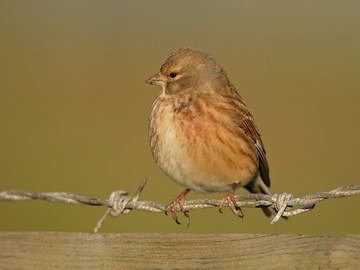
Linnet © Steve Round
The winter map shows a clear contraction in range in the east of the county compared to their breeding distribution, with Linnets found in only about half of the number of tetrads, including only two squares above 150m in altitude. A marked absence from all areas of higher ground was noted in the BTO Winter Atlas, and it is not clear if the birds that breed there undertake altitudinal migration or if it is these birds that preferentially move out of Britain, because Linnets are classic partial migrants. Some British birds remain in winter – apparently an increasing proportion as our winter weather ameliorates – while others move south to winter in a narrow band along the west coast of France, or in Spain (Migration Atlas).
Linnets congregate in seed-rich habitats including, during this survey, stubble fields, including weedy maize stubble, game cover, set-aside farmland, derelict industrial land and saltmarshes. The submitted habitat codes show an even greater proportion on farmland (77%) than in the breeding season, with the proportion on stubble (14%) higher than most other species. The main other habitats used were scrub (9%), human sites (5%) and semi-natural grassland (4%).
They are gregarious birds at all times of year but especially gather into some large flocks in winter. Eleven tetrads held a flock of 100 or more Linnets, with the largest being 420 birds noted by Colin Lythgoe in SJ74D, feeding in a seeding area of game cover, which conveniently flew on to overhead wires to be counted! They are often found in the same areas as other seed-eaters but seem to keep separate: if disturbed, other species tend to head for the nearest cover whilst the Linnets fly up and circle before descending into the feeding area again. At night, they usually assemble in communal roosts, often in gorse, which also can be large. Just five were reported during this survey, containing up to 150 birds.
None of the previous Cheshire ornithological writers has noted the movement of Linnets away from the hills. Coward (1910) wrote that ‘in winter the Linnet is generally distributed, consorting with Chaffinches in the hedgerows and pastures’. Bell (1962) said that ‘its present status has altered little since the early part of the century’, and added that hard weather movements across the Dee have been seen in January and February. With the warming climate, the annual county bird reports have not recorded a frost-driven movement of Linnets since the early 1980s.
Sponsored by Hilbre Observatory and Ringing Station

